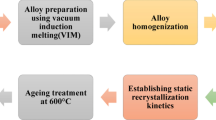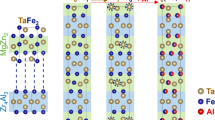Abstract
In this work, the influence of Al-solutes on the mechanical behavior of Cu–Al X solid solutions has been studied using indentation strain rate jump tests for single crystalline and ultrafine-grained (UFG) microstructures from high pressure torsion (HPT) processing. Al-solutes in Cu classically lead to a solid solution strengthening, coupled with a decrease in stacking fault energy, which influences also the grain size after HPT processing. For all alloys, a higher hardness is found at lower indentation depths, which can be nicely described by a modified Nix/Gao model down to 100 nm indentation depth. Among the single crystals, the largest size effects are found for the higher solute contents, indicating a stronger work hardening at small length scales for the solid solutions. The dilute UFG solid solutions showed a strong softening after a strain rate reduction test, with a pronounced transient region. Cu–Al15 is, however, quite stable, showing abrupt changes in hardness without strong transients. This indicates that solute solution strengthening does not only influence the indentation size effect and structure formation during HPT processing but also stabilizes the grain structure during subsequent deformation.





Similar content being viewed by others
References
B. Backes, K. Durst, and M. Göken: Determination of plastic properties of polycrystalline metallic materials by nanoindentation: Experiments and finite element simulations. Philos. Mag. 86, 5541 (2006).
R.Z. Valiev, I.V. Alexandrov, Y.T. Zhu, and T.C. Lowe: Paradoxon of strength and ductility in metals processed by SPD. J. Mater. Res. 17, 5 (2002).
H.W. Höppel, J. May, and M. Göken: Enhanced strength and ductility in ultrafine-grained aluminium produced by accumulative roll bonding. Adv. Eng. Mater. 6, 781 (2004).
J. May, H.W. Höppel, and M. Göken: Strain rate sensitivity of ultrafine-grained aluminium processed by severe plastic deformation. Scr. Mater. 53, 189 (2005).
J. May, H.W. Höppel, and M. Göken: Strain rate sensitivity of ultrafine grained fcc- and bcc-type metals. Mater. Sci. Forum 503–504, 781 (2006).
Y.J. Li, J. Mueller, H.W. Höppel, M. Göken, and W. Blum: Deformation kinetics of nanocrystalline nickel. Acta Mater. 55, 5708 (2007).
W.D. Nix and H. Gao: Indentation size effects in crystalline materials: A law for strain gradient plasticity. J. Mech. Phys. Solids 46, 411 (1998).
B. Backes, Y.Y. Huang, M. Göken, and K. Durst: The correlation between the internal material length scale and the microstructure in nanoindentation experiments and simulations using the conventional mechanism-based strain gradient plasticity theory. J. Mater. Res. 24, 1197 (2009).
D. Kiener, K. Durst, M. Rester, and A.M. Minor: Revealing deformation mechanisms with nanoindentation. JOM 61, 14 (2009).
M.A. Lodes, A. Hartmaier, M. Göken, and K. Durst: Influence of dislocation density on the pop-in behavior and indentation size effect in CaF2 single crystals: Experiments and molecular dynamics simulations. Acta Mater. 59 (2011).
K. Durst, O. Franke, A. Böhner, and M. Göken: Indentation size effect in Ni–Fe solid solutions. Acta Mater. 55, 6825 (2007).
V. Maier, K. Durst, J. Mueller, B. Backes, H.W. Höppel, and M. Göken: Nanoindentation strain-rate jump tests for determining the local strain-rate sensitivity in nanocrystalline Ni and ultrafine-grained Al. J. Mater. Res. 26, 1421 (2011).
V. Maier, B. Merle, M. Göken, and K. Durst: An improved long-term nanoindentation creep testing approach for studying the local deformation processes in nanocrystalline metals at room and elevated temperatures. J. Mater. Res. 28, 1177 (2013).
R. Pippan, S. Scheriau, A. Hohenwarter, and M. Hafok: Advantages and limitations of HPT: A review. Mater. Sci. Forum 584–586, 16 (2008).
K. Edalati and Z. Horita: A review on high-pressure torsion (HPT) from 1935 to 1988. Mater. Sci. Eng., A 652, 325 (2016).
X.H. An, S. Qu, S.D. Wu, and Z.F. Zhang: Effects of stacking fault energy on the thermal stability and mechanical properties of nanostructured Cu–Al alloys during thermal annealing. J. Mater. Res. 26, 407 (2011).
X.H. An, S.D. Wu, and Z.F. Zhang: Influence of stacking fault energy on the microstructures and grain refinement in the Cu–Al alloys during equal-channel angular pressing. Mater. Sci. Forum 667–669, 379 (2011).
X.H. An, S.D. Wu, Z.F. Zhang, R.B. Figueiredo, N. Gao, and T.G. Langdon: Evolution of microstructural homogeneity in copper processed by high-pressure torsion. Scr. Mater. 63, 560 (2010).
X.H. An, Q.Y. Lin, S.D. Wu, Z.F. Zhang, R.B. Figueiredo, N. Gao, and T.G. Langdon: Formation of fivefold deformation twins in an ultrafine-grained copper alloy processed by high-pressure torsion. Scr. Mater. 64, 249 (2011).
X.H. An, W.Z. Han, C.X. Huang, P. Zhang, G. Yang, S.D. Wu, and Z.F. Zhang: High strength and utilizable ductility of bulk ultrafine-grained Cu–Al alloys. Appl. Phys. Lett. 92, 23 (2008).
W.Z. Han, Z.F. Zhang, S.D. Wu, and S.X. Li: Combined effects of crystallographic orientation, stacking fault energy and grain size on deformation twinning in fcc crystals. Philos. Mag. 88, 3011 (2008).
Y.L. Gong, C.E. Wen, X.X. Wu, S.Y. Ren, L.P. Cheng, and X.K. Zhu: The influence of strain rate, deformation temperature and stacking fault energy on the mechanical properties of Cu alloys. Mater. Sci. Eng., A 583, 199 (2013).
Y. Zhang, N.R. Tao, and K. Lu: Effects of stacking fault energy, strain rate and temperature on the microstructure and strength of nanostructured Cu–Al alloys subjected to plastic deformation. Acta Mater. 59, 6048 (2011).
M. Hafok and R. Pippan: Influence of stacking fault energy and alloying on stage V hardening of HPT-deformed materials. Int. J. Mater. Res. 101, 1097 (2010).
K. Edalati, D. Akama, A. Nishio, S. Lee, Y. Yonenaga, J.M. Cubero-Sesin, and Z. Horita: Influence of dislocation–solute atom interactions and stacking fault energy on grain size of single-phase alloys after severe plastic deformation using high-pressure torsion. Acta Mater. 69, 68 (2014).
A. Hohenwarter, A. Taylor, R. Stock, and R. Pippan: Effect of large shear deformations on the fracture behavior of a fully pearlitic steel. Metallurgical and Materials Transactions A 42, 1609 (2011).
X. An, Q. Lin, S. Wu, and Z. Zhang: Improved fatigue strengths of nanocrystalline Cu and Cu–Al alloys. Mater. Res. Lett. 3, 135 (2015).
P.C.J. Gallagher: The influence of alloying, temperature, and related effects on the stacking fault energy. Metall. Trans. 1, 2429 (1970).
O. Engler: Deformation and texture of copper–manganese alloys. Acta Mater. 48, 4827 (2000).
W.C. Oliver and G.M. Pharr: Improved technique for determining hardness and elastic modulus using load and displacement sensing indentation experiments. J. Mater. Res. 7, 1564 (1992).
K. Durst and V. Maier: Dynamic nanoindentation testing for studying thermally activated processes from single to nanocrystalline metals. Curr. Opin. Solid State Mater. Sci. 19, 340 (2015).
G.M. Pharr, J.H. Strader, and W.C. Oliver: Critical issues in making small-depth mechanical property measurements by nanoindentation with continuous stiffness measurement. J. Mater. Res. 24, 653 (2009).
B. Merle, V. Maier-Kiener, and G.M. Pharr: Influence of modulus-to-hardness ratio and harmonic parameters on continuous stiffness measurement during nanoindentation. Acta Mater. 134, 167 (2017).
B.N. Lucas and W.C. Oliver: Indentation power-law creep of high-purity indium. Metall. Mater. Trans. A 30, 601 (1999).
V. Maier, C. Schunk, M. Göken, and K. Durst: Microstructure-dependent deformation behaviour of bcc-metals—Indentation size effect and strain rate sensitivity. Philos. Mag. 95, 1766 (2014).
Q. Wei, S. Cheng, K.T. Ramesh, and E. Ma: Effect of nanocrystalline and ultrafine grain sizes on the strain rate sensitivity and activation volume: Fcc versus bcc metals. Mater. Sci. Eng., A 381, 71 (2004).
K. Durst, B. Backes, and M. Göken: Indentation size effect in metallic materials: Correcting for the size of the plastic zone. Scr. Mater. 52, 1093 (2005).
M. Rester, C. Motz, and R. Pippan: Stacking fault energy and indentation size effect: DO they interact? Scr. Mater. 58, 187 (2008).
A.A. Elmustafa and D.S. Stone: Stacking fault energy and dynamic recovery: Do they impact the indentation size effect? Mater. Sci. Eng., A 358, 1 (2003).
A. Portevin and H. Le Chatelier: Heat treatment of aluminium-copper alloys. Trans. Am. Soc. Steel Treat. 5, 457 (1924).
W. Blum and X.H. Zeng: A simple dislocation model of deformation resistance of ultrafine-grained materials explaining Hall–Petch strengthening and enhanced strain rate sensitivity. Acta Mater. 57, 1966 (2009).
N. Ahmed and A. Hartmaier: Mechanisms of grain boundary softening and strain-rate sensitivity in deformation of ultrafine-grained metals at high temperatures. Acta Mater. 59, 4323 (2011).
X.X. Wu, X.Y. San, Y.L. Gong, L.P. Chen, C.J. Li, and X.K. Zhu: Studies on strength and ductility of Cu–Zn alloys by stress relaxation. Mater. Des. 47, 295 (2013).
W. Blum, Y.J. Li, and K. Durst: Stability of ultrafine-grained Cu to subgrain coarsening and recrystallization in annealing and deformation at elevated temperatures. Acta Mater. 57 (17), 5207–5217 (2009).
ACKNOWLEDGMENTS
Parts of the experimental work were performed when V.M-K. and K.D. were still at the Chair of General Materials Properties (FAU Erlangen-Nürnberg); therefore, the authors thank Prof. M. Göken for his support. Further, financial support by the Austrian Federal Government (837900) within the framework of the COMET Funding Program (MPPE, A7.19) (V.M-K.) and by the ERC (USMS: 340185) (R.P.) as well as the National Natural Science Foundation of China (NSFC) under grant Nos. 51331007 and 51471170 (Z.F.) is highly appreciated.
Author information
Authors and Affiliations
Corresponding author
Rights and permissions
About this article
Cite this article
Maier-Kiener, V., An, X., Li, L. et al. Influence of solid solution strengthening on the local mechanical properties of single crystal and ultrafine-grained binary Cu–Al X solid solutions. Journal of Materials Research 32, 4583–4591 (2017). https://doi.org/10.1557/jmr.2017.320
Received:
Accepted:
Published:
Issue Date:
DOI: https://doi.org/10.1557/jmr.2017.320




